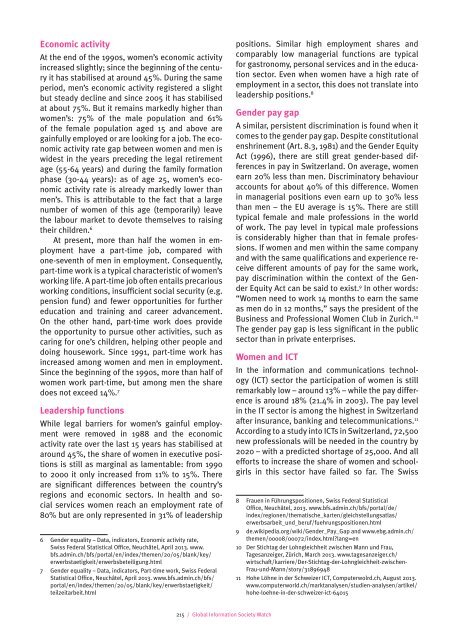gisw13_chapters
gisw13_chapters
gisw13_chapters
Create successful ePaper yourself
Turn your PDF publications into a flip-book with our unique Google optimized e-Paper software.
Economic activityAt the end of the 1990s, women’s economic activityincreased slightly; since the beginning of the centuryit has stabilised at around 45%. During the sameperiod, men’s economic activity registered a slightbut steady decline and since 2005 it has stabilisedat about 75%. But it remains markedly higher thanwomen’s: 75% of the male population and 61%of the female population aged 15 and above aregainfully employed or are looking for a job. The economicactivity rate gap between women and men iswidest in the years preceding the legal retirementage (55-64 years) and during the family formationphase (30-44 years): as of age 25, women’s economicactivity rate is already markedly lower thanmen’s. This is attributable to the fact that a largenumber of women of this age (temporarily) leavethe labour market to devote themselves to raisingtheir children. 6At present, more than half the women in employmenthave a part-time job, compared withone-seventh of men in employment. Consequently,part-time work is a typical characteristic of women’sworking life. A part-time job often entails precariousworking conditions, insufficient social security (e.g.pension fund) and fewer opportunities for furthereducation and training and career advancement.On the other hand, part-time work does providethe opportunity to pursue other activities, such ascaring for one’s children, helping other people anddoing housework. Since 1991, part-time work hasincreased among women and men in employment.Since the beginning of the 1990s, more than half ofwomen work part-time, but among men the sharedoes not exceed 14%. 7Leadership functionsWhile legal barriers for women’s gainful employmentwere removed in 1988 and the economicactivity rate over the last 15 years has stabilised ataround 45%, the share of women in executive positionsis still as marginal as lamentable: from 1990to 2000 it only increased from 11% to 15%. Thereare significant differences between the country’sregions and economic sectors. In health and socialservices women reach an employment rate of80% but are only represented in 31% of leadership6 Gender equality – Data, indicators, Economic activity rate,Swiss Federal Statistical Office, Neuchâtel, April 2013. www.bfs.admin.ch/bfs/portal/en/index/themen/20/05/blank/key/erwerbstaetigkeit/erwerbsbeteiligung.html7 Gender equality – Data, indicators, Part-time work, Swiss FederalStatistical Office, Neuchâtel, April 2013. www.bfs.admin.ch/bfs/portal/en/index/themen/20/05/blank/key/erwerbstaetigkeit/teilzeitarbeit.htmlpositions. Similar high employment shares andcomparably low managerial functions are typicalfor gastronomy, personal services and in the educationsector. Even when women have a high rate ofemployment in a sector, this does not translate intoleadership positions. 8Gender pay gapA similar, persistent discrimination is found when itcomes to the gender pay gap. Despite constitutionalenshrinement (Art. 8.3, 1981) and the Gender EquityAct (1996), there are still great gender-based differencesin pay in Switzerland. On average, womenearn 20% less than men. Discriminatory behaviouraccounts for about 40% of this difference. Womenin managerial positions even earn up to 30% lessthan men – the EU average is 15%. There are stilltypical female and male professions in the worldof work. The pay level in typical male professionsis considerably higher than that in female professions.If women and men within the same companyand with the same qualifications and experience receivedifferent amounts of pay for the same work,pay discrimination within the context of the GenderEquity Act can be said to exist. 9 In other words:“Women need to work 14 months to earn the sameas men do in 12 months,” says the president of theBusiness and Professional Women Club in Zurich. 10The gender pay gap is less significant in the publicsector than in private enterprises.Women and ICTIn the information and communications technology(ICT) sector the participation of women is stillremarkably low – around 13% – while the pay differenceis around 18% (21.4% in 2003). The pay levelin the IT sector is among the highest in Switzerlandafter insurance, banking and telecommunications. 11According to a study into ICTs in Switzerland, 72,500new professionals will be needed in the country by2020 – with a predicted shortage of 25,000. And allefforts to increase the share of women and schoolgirlsin this sector have failed so far. The Swiss8 Frauen in Führungspositionen, Swiss Federal StatisticalOffice, Neuchâtel, 2013. www.bfs.admin.ch/bfs/portal/de/index/regionen/thematische_karten/gleichstellungsatlas/erwerbsarbeit_und_beruf/fuehrungspositionen.html9 de.wikipedia.org/wiki/Gender_Pay_Gap and www.ebg.admin.ch/themen/00008/00072/index.html?lang=en10 Der Stichtag der Lohngleichheit zwischen Mann und Frau,Tagesanzeiger, Zürich, March 2013. www.tagesanzeiger.ch/wirtschaft/karriere/Der-Stichtag-der-Lohngleichheit-zwischen-Frau-und-Mann/story/3189694811 Hohe Löhne in der Schweizer ICT, Computerwolrd.ch, August 2013.www.computerworld.ch/marktanalysen/studien-analysen/artikel/hohe-loehne-in-der-schweizer-ict-64015215 / Global Information Society Watch


